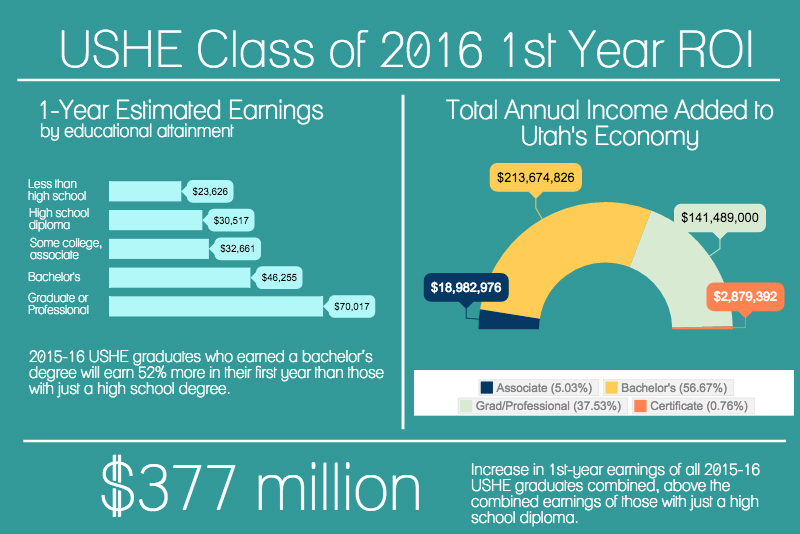In recent years, longitudinal data has become an oft-referenced term in relation to educational data. The Utah System of Higher Education (USHE) has long utilized longitudinal data to inform policy decisions and provide reporting information to the Board of Regents, the state legislature and other primary stakeholders.
USHE has used a central data warehouse since 1997, from which an annual data book has been published. The Data Book provides aggregate data in key areas such as budgeting, degree awards, staffing, salaries, and facilities. As higher education is a large enterprise with many moving pieces, it is critical that this data is accessible, credible, and transparent.
More recently, technological innovations have enabled much broader analysis of large data systems. USHE has recently undertaken efforts to work more closely with its data inputs (K-12) and data outputs (workforce information) to better understand how well higher education in Utah is supporting its economic development needs in the state. On the input side, USHE institutions enroll 8 out of 10 Utah high school graduates who go on to college. On the output side, USHE institutions award over 80% of the state’s post-secondary degrees and certificates. As the primary entity in the education-to-workforce pipeline, high quality data is important to USHE. Higher education leaders greatly value their relationship with data partners at the Utah State Board of Education and the Utah Department of Workforce Services, which make it possible to provide these improved types of longitudinal analyses.
Uses of longitudinal data by USHE
A report compiled by the Office of the Commissioner was provided to all district superintendents and high school principals showing the first year college performance of students from their graduating classes of 2014-15 who enrolled at a USHE institution the following year. The report, provided annually, informs K-12 administrators on key higher education performance indicators to assist them in preparing students for college. It contains information such as the institution where graduates are enrolled, the percentage of students who met the Math and English ACT college readiness benchmarks, and the percentage of students who completed remedial and/or college-level math and English courses by the end of their first year of college. State and district versions of the report are available online.
Estimated first year earnings of USHE graduates
In Utah, 2016 USHE graduates will earn $400 million more in wages than those with a high school diploma during their first year in the workforce—an average of over $13,000 more per graduate. This also includes all USHE awards, from certificates to graduate degrees, where the income premium varies significantly by attainment level and degree type. These estimates use data from the U.S. Census on college graduates participating in the workforce as well as its projected wage increase by degree attainment in Utah.
Math enrollment and college graduation
The Office of the Commissioner conducted a study on the college performance of Utah high school graduates based on math course-taking patterns in high school and college. The study found that students who enroll in any math course their first year in college, who haven’t already met their general math or quantitative literacy requirements (QL), are three times more likely to meet this requirement than those who do not take math their first year.
The study also found that students who successfully completed high school math beyond Math 3 for their last math class in high school are twice as likely to successfully meet their college math requirement.
Higher education and the Utah Data Alliance
In addition to USHE’s individual efforts to use longitudinal data more effectively, it is also a member of the Utah Data Alliance (UDA), a partnership funded to make education data more accessible and usable through sound and secure practices. The other five partners are: The Department of Workforce Services, The Utah College of Applied Technology, Utah Education Network, the Utah Education Policy Center (at the University of Utah), and the Utah State Board of Education (USBE).
In 2009, USHE was a supporting partner to USBE in securing federal funds to establish a state longitudinal data system (SLDS) that includes postsecondary and workforce information. The funding was to motivate states in establishing statewide education data systems to enable better decision-making in education. A significant portion of these funds were to assist USBE in many of its efforts to establish state-level K-12 data systems. These funds were used by UDA partners for the establishment of a multi-entity data warehouse in which data historically housed in separate silos could now be shared. From 2011-2012, UDA partners built the essential technological infrastructure to make this possible. In 2013, data quality and analysis began.
In 2014, the Utah legislature extended its support of UDA via SB34 with ongoing funds to continue its efforts. Those funds provide the needed staffing resources and technology licensing to maintain current UDA efforts.
USHE-led initiatives utilizing UDA resources:
Industries in which USHE graduates are employed – first year after college
This interactive bubble chart shows where graduates from USHE institutions are employed the first year after completing college. Users can select by field of study, institution, and academic year.
The data is based on employment one-year post graduation. Industry definitions are from the U.S. Bureau of Labor and Statistics. There are many graduates of USHE institutions for whom their employment status is unknown. For example, they are unemployed, employed out of state, or a connection to a field of employment is unknown.
Utah wage information by field of study
The interactive illustrates the range of wages of college graduates earn five years after graduation. Users can search by area of study and institution. This information was compiled by USHE in partnership with the Utah Department of Workforce Services.
There are some inherent factors that, if ignored, can lead to misinterpretation. For example, geography, specific circumstances of an individual or business, or current economic and regulatory conditions can significantly impact an individual’s wage potential.
Job placement rates of USHE graduates
This data shows the job placement rates of USHE graduates employed in Utah by area of study and degree type. This information was compiled by USHE in partnership with the Utah Department of Workforce Services.
Report: Building Utah’s Future through Higher Education
This report, published in April 2014, estimates the return on investment (ROI) if the state were to achieve the aggressive goal set by the Governor and supported by the state legislature that by the year 2020, 66% of Utah’s adult population will have earned a post-secondary degree or certificate. Also known as the 66by2020 goal, it is focused on Utahns ages 25-35 in 2020. This document estimates some of the potential economic impacts that attaining this goal will have on Utah’s tax base, economy and poverty levels, both annually and in 30 years. For example, it estimates that reaching this goal will result in $14.4 billion added to the Utah economy in increased wages over 30 years. In addition, it is estimated that 42,057 Utahns will escape the cycle of intergenerational poverty through greater educational attainment.
Data security
USHE, as well as all the UDA partner agencies, operate under the requirements of the Family Educational Rights and Privacy ACT (FERPA), a federal law defining requirements of education data ownership, use, and sharing, including the prohibited sale of a student’s personally identifiable information. It also adheres to all other applicable federal and state laws pertaining to data management. In addition, the education data maintained in the USHE data warehouse follows strict technological protocols to ensure the most secure environment possible.


